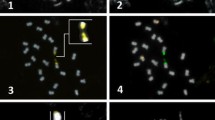Abstract
The diploid number(2n)and fundamental number (FN) were 44 and 64 inMustela erminea nippon and 38 and 64 inM. sibirica itatsi. In spite of such a marked dissimilarity in their chromosome constitution, most of the chromosomes of these two species showed high G-band homology. On the other hand, interspecific variations in the amount of C-heterochromatin were observed in several pairs of chromosomes which were regarded, based on their G-banding patterns, to have arisen from a common origin. Some of the chromosome pairs associated with the C-heterochromatin variations showed significant differences in length or arm ratio, whereas others did not. These findings strongly indicate that the G-banding patterns might have been well conserved, at least in the euchromatic regions, through the speciation process; in contrast, C-heterochromatin showed quantitative variations, some of which could be regarded to have been formed by duplication.
Thus, the karyological relationships between the Japanese ermine and the Japanese weasel could be explained by Robertsonian fusion and quantitative alteration of C-heterochromatin.
Similar content being viewed by others
References
Bengtsson, B. O., 1980. Rates of karyotype evolution in placental mammals. Hereditas 92: 37–47.
Fredga, K. & Mandahl, N., 1973. Autosomal heterochromatin in some carnivores. Nobel Symp. Med. Natur. Sci. 23: 104–117.
Grafodatsky, A. S., Volobuev, V. T., Ternovsky, D. V. & Radjabli, S. I., 1976. G-banding of the chromosomes in seven species of Mustelidae(Carnivora). Zool. J. 55: 1704–1709 (in Russian, with English summary).
Grafodatsky, A. S., Ternovsky, D. V., Isaenko, A. A. & Radjabli, S. L. 1977. Constitutive heterochromatin and DNA content in some mustelids(Mustelidae, Carnivora). Genetika 13: 2123–2128 (in Russian, with English summary).
Harada, M. & Yosida, T. H., 1978. Karyological study of four Japanese Myotis bats (Chiroptera, Mammalia). Chromosoma 65: 283–291.
Mandahl, N., 1978. Variation in C-stained chromosome regions in European hedgehogs (Insectivora, Mammalia). Hereditas 89: 107–128.
Mandahl, N. & Fredga, K., 1975. Q-, G- and C-band patterns of the mink chromosomes. Hereditas 81: 211–220.
Mandahl, N. & Fredga, K., 1980. A comparative chromosome study by means of G-, C- and NOR-bandings of the weasel, the pygmy weasel and the stoat (Mustela, Carnivora, Mammalia). Hereditas 93: 75–83.
Mascarello, J. T. & Mazrimas, J. A., 1977. Chromosomes of antelope squirrels (Genus Ammospermophilus): A systematic banding analysis of four species with unusual constitutive heterochromatin. Chromosoma 64: 207–217.
Obara, Y. & Miyai, T., 1981. A preliminary study on the sex chromosome variation in the Japanese house shrew, Suncus murinus riukiuanus. Japan. J. Genet. 56: 365–371.
Obara, Y., 1982a. Comparative analysis of karyotypes in the Japanese mustelids, Mustela nivalis namiyei and M. erminea nippon. J. Mammal. Soc. Japan 9: 59–69.
Obara, Y., 1982b. C- and G-banded karyotypes of the Japanese marten, Martes melampus melampus. Chrom. Inf. Serv. 33: 21–23.
Obara. Y., 1984. C-bands and late DNA replication in the chromosomes of the Japanese least weasel, Mustela nivalis namiyei. Chrom. Inf. Serv. 36: 24–26.
Obara, Y., 1985. Karyological relationship between two species of mustelids, the Japanese ermine and the least weasel. Japan. J. Genet. 60: 157–160.
Pathak, S., Hsu, T. C. & Arrighi, F. E., 1973. Chromosomes of Peromyscus (Rodentia, Cricetidae). IV. The role of heterochromatin in karyotype evolution. Cytogenet. Cell Genet. 12:315–326.
Pathak, S. & Wurster-Hill, D. H., 1977. Distribution of constitu-tive heterochromatin in carnivores. Cytogenet. Cell Genet. 18:245–254.
Patton, J. L. & Sherwood, W., 1982. Genome evolution in pocket gophers (Genus Thomomys). 1. Heterochromatin variation and speciation potential. Chromosoma 85: 149–162.
Stock, A. D. & Hsu, T. C., 1973. Evolutionary conservatism in arrangement of genetic material. Chromosoma 43: 211–224.
Sumner, A. T., Evans, H. J. & Buckland, R. A., 1971. New technique for distinguishing between human chromosomes. Nature (Lond.) New Biol. 232: 31–32.
Sumner, A. T., 1972. A simple technique for demonstrating centromeric heterochromatin. Expl Cell Res. 75: 304–306.
Wurster-Hill, D. H. & Centerwall, W. R., 1982. The interrelationships of chromosome banding patterns in canids, mustelids, hyena and felids. Cytogenet. Cell Genet. 34: 178–192.
Yoshida, M. A., Takagi, N. & Sasaki, M., 1983. Karyotypic kinship between the blue fox (Alopex lagopus Linn.) and the silver fox (Vulpes fulva Desm.). Cytogenet. Cell Genet. 35: 190–194.
Author information
Authors and Affiliations
Rights and permissions
About this article
Cite this article
Obara, Y. G-band homology and C-band variation in the Japanese mustelids,Mustela erminea nippon andM. sibirica itatsi . Genetica 68, 59–64 (1985). https://doi.org/10.1007/BF02424566
Received:
Accepted:
Issue Date:
DOI: https://doi.org/10.1007/BF02424566




